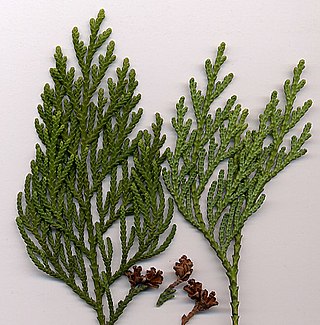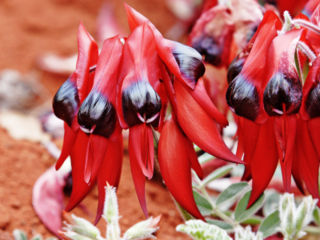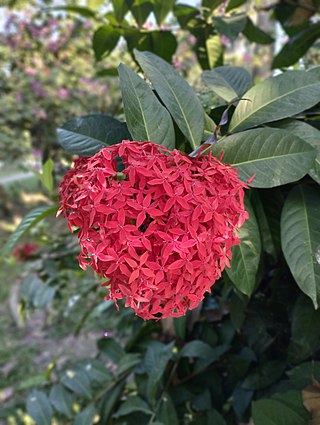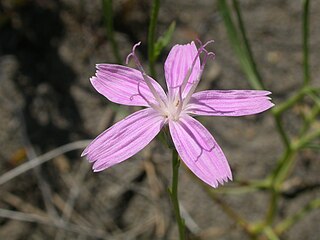
Thuja is a genus of coniferous tree or shrub in the Cupressaceae. There are five species in the genus, two native to North America and three native to eastern Asia. The genus is monophyletic and sister to Thujopsis. Members are commonly known as arborvitaes, thujas or cedars.

In the botanical classification of plants, Aeridinae Pfitzer is a subtribe of the tribe Vandeae whose representatives all have a monopodial growth habit and do not possess pseudobulbs.

Bignoniaceae is a family of flowering plants in the order Lamiales commonly known as the bignonias or trumpet vines. It is not known to which of the other families in the order it is most closely related.

Aralia, or spikenard, is a genus of the family Araliaceae, consisting of 68 accepted species of deciduous or evergreen trees, shrubs, and rhizomatous herbaceous perennials. The genus is native to Asia and the Americas, with most species occurring in mountain woodlands. Aralia plants vary in size, with some herbaceous species only reaching 50 centimetres (20 in) tall, while some are trees growing to 20 metres (66 ft) tall.

Scabiosa is a genus in the honeysuckle family (Caprifoliaceae) of flowering plants. Many of the species in this genus have common names that include the word scabious, but some plants commonly known as scabious are currently classified in related genera such as Knautia and Succisa; at least some of these were formerly placed in Scabiosa. Another common name for members of this genus is pincushion flowers.

Jacaranda is a genus of 49 species of flowering plants in the family Bignoniaceae, native to tropical and subtropical regions of the Americas while cultivated around the world. The generic name is also used as the common name.

Melastomataceae is a family of dicotyledonous flowering plants found mostly in the tropics comprising c. 175 genera and c. 5115 known species. Melastomes are annual or perennial herbs, shrubs, or small trees.

Swainsona formosa, commonly known as Sturt's desert pea or Sturt pea, is a species of flowering plant in the family Fabaceae and is native to all continental states and the Northern Territory of Australia, with the exception of Victoria. It is a prostrate annual or short lived perennial herb with imparipinnate leaves with about 15 elliptic to egg-shaped leaflets with the narrower end towards the base, and racemes of usually red flowers in racemes of 2 to 6.
George Don was a Scottish botanist and plant collector.

Purshia is a small genus of 5–8 species of flowering plants in the family Rosaceae which are native to western North America.

Tiarella, the foamflowers, is a genus of flowering plants in the family Saxifragaceae. The generic name Tiarella means "little turban", which suggests the shape of the seed capsules. Worldwide there are seven species, one each in eastern Asia and western North America, plus five species in eastern North America. As of October 2022, the taxonomy of Tiarella in eastern North America is in flux.

Nomocharis is a genus of flowering plants in the family Liliaceae. It consists of about 7 species native to montane regions of western China, Myanmar, and northern India. They are similar to Lilium, with one of the more obvious differences being the flowers being more shallow or sometimes flat.

Microseris is a genus of plants in the tribe Cichorieae within the family Asteraceae, plants that often called composites. They are native to North America, South America, Australia, and New Zealand.

Ixora is a genus of flowering plants in the family Rubiaceae. It is the only genus in the tribe Ixoreae. It consists of tropical evergreen trees and shrubs and holds around 544 species. Though native to the tropical and subtropical areas throughout the world, its centre of diversity is in Tropical Asia. Ixora also grows commonly in subtropical climates in the United States, such as Florida where it is commonly known as West Indian jasmine.

Agarista is a genus of plants in the family Ericaceae. Agarista species contain grayanotoxins, a group of closely related neurotoxins named after Leucothoe grayana, native to Japan.

Operculina is a genus of plants in the morning-glory family which that are found throughout the world.

Lumnitzera is an Indo-West Pacific mangrove genus in the family Combretaceae. An English common name is black mangrove. Lumnitzera, named after the German botanist, Stephan Lumnitzer (1750-1806), occurs in mangroves from East Africa to the Western Pacific, and northern Australia.

Trachystemon is a monotypic genus of flowering plants belonging to the family Boraginaceae. The only species is Trachystemon orientalis, commonly known as Abraham-Isaac-Jacob or early-flowering borage.
Culcitium is a genus of flowering plants belonging to the family Asteraceae.

Lygodesmia juncea, the rush skeletonplant or just skeletonweed, is a species of flowering plant in the family Asteraceae, native to the western and central United States and western Canada. Widespread and considered somewhat weedy, it is adapted to blowing or otherwise disturbed soils, but not to fire. It is a perennial herb. Petals are pink or violet in color and flowers bloom June to September.

















